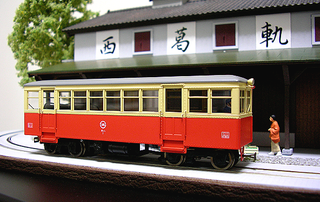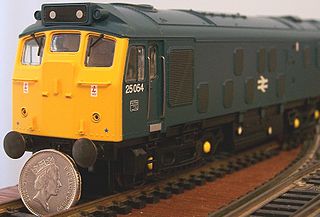Related Research Articles

Railway modelling or model railroading is a hobby in which rail transport systems are modelled at a reduced scale.

G scale or G gauge, also called large scale, is a track gauge for model railways which is often used for outdoor garden railways because of its size and durability. G scale trains use a fixed track gauge of 45 millimetres (1.75 in) to accommodate a range of rail transport modelling scales between narrow gauge (~1:13‒1:19‒1:20), metre gauge (1:22.5), Playmobil trains (~1:24), and standard gauge (~1:29–1:32).

OO gauge or OO scale is the most popular standard gauge model railway standard in the United Kingdom, outside of which it is virtually unknown. OO gauge is one of several 4 mm-scale standards, and the only one to be marketed by major manufacturers. The OO track gauge of 16.5 mm corresponds to prototypical gauge of 4 ft 1+1⁄2 in, rather than 4 ft 8+1⁄2 in standard gauge. However, since the 1960s, other gauges in the same scale have arisen—18.2 mm (EM) and 18.83 mm (Scalefour)—to reflect the desire of some modellers for greater scale accuracy.

O scale is a scale commonly used for toy trains and rail transport modelling. Introduced by German toy manufacturer Märklin around 1900, by the 1930s three-rail alternating current O gauge was the most common model railroad scale in the United States and remained so until the early 1960s. In Europe, its popularity declined before World War II due to the introduction of smaller scales.

N scale is a popular model railway scale. Depending upon the manufacturer, the scale ranges from 1:148 to 1:160. Effectively the scale is 1:159, 9 mm to 1,435 mm, which is the width of standard gauge railway. However the scale may vary to simulate wide or narrow gauge rail. In all cases, the gauge is 9 mm or 0.354 in. The term N gauge refers to the track dimensions, but in the United Kingdom in particular British N gauge refers to a 1:148 scale with 1:160 track gauge modelling. The terms N scale and N gauge are often inaccurately used interchangeably, as scale is defined as ratio or proportion of the model, and gauge only as a distance between rails. The scale 1:148 defines the rail-to-rail gauge equal to 9 mm exactly, so when calculating the rail or track use 1:160 and for engines and car wheel base use 1:148.

2 mm scale, often 2 mm finescale is a specification used for railway modelling, largely for modelling British railway prototypes. It uses a scale of 2 mm on the model to 1 foot on the prototype, which scales out to 1:152. The track gauge used to represent prototype standard gauge is 9.42 mm. Track and wheels are closer to dead scale replicas than commercial British N.
Protofour or P4 is a set of standards for model railways allowing construction of models to a scale of 4 mm to 300 mm (1 ft) (1:76.2), the predominant scale of model railways of the British prototype. For historical reasons almost all manufacturers of British prototype models use 00 gauge. There are several finescale standards which have been developed to enable more accurate models than 00, and P4 is the most accurate in common use.

OO9, often also denoted as 009 or 00-9 is a model railway scale and gauge combination of 4 mm scale and 9 mm gauge tracks, which models a prototype track gauge of 2 ft 3 in. It is a common choice in the United Kingdom for the modelling of narrow-gauge railways whose prototype gauges lie approximately between 2 ft and 2 ft 6 in. The 9 mm track gauge is used by N gauge model railways, a common commercial scale, which means that a selection of wheels, track, and mechanisms is readily available.

4 mm scale is the most popular model railway scale used in the United Kingdom. The term refers to the use of 4 millimeters on the model equating to a distance of 1 foot (305 mm) on the prototype (1:76.2). It is also used for military modelling.

A garden railway or garden railroad is a model railway system set up outdoors in a garden. While G is the most popular scale for garden railroads, 16 mm scale has a dedicated and growing following especially in the UK. Model locomotives in this scale are often live steam scale models of British narrow gauge prototypes. 16 mm scale track, the same gauge as O gauge is probably now more popular in the UK than G scale.

16 mm to 1 foot or 1:19.05 is a popular scale of model railway in the UK which represents narrow gauge prototypes. The most common gauge for such railways is 32 mm, representing 2 ft gauge prototypes. This scale/gauge combination is sometimes referred to as "SM32" and is often used for model railways that run in gardens, being large enough to easily accommodate live steam models. The next most common gauge is 45 mm, which represents the theoretical non-existent gauge 2 feet 9+3⁄4 inches (857 mm). This gauge is commonly used to portray prototypes between 2 ft 6 in and 3 ft gauge.
HOn30 gauge is the modelling of narrow-gauge railways in HO on N gauge track in 1:87 scale ratio.

On30gauge is the modelling of narrow gauge railways in O scale on HO gauge track in 1:48 scale ratio by American and Australian model railroaders, in 1:43.5 scale ratio by British and French model railroaders and 1:45 by Continental European model railroaders.

O14 is a set of model railway standards for accurately modelling 2 ft narrow-gauge railways in 1:43.5 using 14 mm (0.551 in) gauge track.
3' Gauge rail modelling is a specialisation in rail transport modelling. Specifically it relates to the modelling of narrow gauge prototypes of 3 ft gauge. This gauge was the most common narrow gauge in the United States and in Ireland. Apart from some other lines in North, Central and South America, 3 ft gauge was uncommon elsewhere. Therefore, most 3 ft gauge modellers model either United States or Irish prototypes.

5.5 mm to 1 foot scale is used for modelling narrow gauge railways. 12 mm gauge track is used to represent 2 ft to 2 ft 3 in gauge prototypes. 16.5 mm gauge track is used to represent 3 ft gauge prototypes. Very narrow industrial or rural lines can be represented by N-gauge on OO9-track do give 18 in. These 5.5mm could be called "5.5-ind".

On2 gauge is part of the hobby of rail transport modeling. The name is based on the common USA model railroad O scale of 1:48 and refers to the gauge between the rails and the fact that it is narrow gauge, thus 'On2'.

Two foot and 600 mm gauge railways are narrow gauge railways with track gauges of 2 ft and 600 mm, respectively. Railways with similar, less common track gauges, such as 1 ft 11+3⁄4 in and 1 ft 11+1⁄2 in, are grouped with 2 ft and 600 mm gauge railways.
References
- 1 2 3 4 5 7mmnga.org.uk: What We Do Archived 4 May 2007 at the Wayback Machine (Retrieved 05/02/08)
- 1 2 7mmnga.org.uk: Area Groups Archived 4 May 2007 at the Wayback Machine (Retrieved 05/02/08)
- "Narrow Lines" magazine